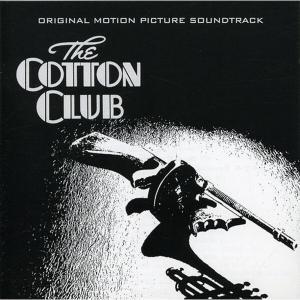 I could not have been more pleased when Mike Zirpolo contacted me, and asked me to share my memories about having played for the soundtrack of Francis Ford Coppola’s film, Cotton Club. I was able to tell Mike that I happily recall many of the details about that special episode in my life. I am glad to share some of them with you here.
I could not have been more pleased when Mike Zirpolo contacted me, and asked me to share my memories about having played for the soundtrack of Francis Ford Coppola’s film, Cotton Club. I was able to tell Mike that I happily recall many of the details about that special episode in my life. I am glad to share some of them with you here.
It was the virtuoso guitarist Howard Alden who encouraged me to follow his lead and move from southern California to New York City. I got to the Big Apple in February of 1983, about a year after Howard. I had the good fortune to have a steady gig already waiting for me, as I’d agreed to join the Widespread Depression Orchestra before I left California. If anything, that band was ahead of its time, and presaged the “Swing Era” revival that occurred about fifteen years later. (On the advice of management, the band changed its name to the Widespread Jazz Orchestra. I’ve always preferred the original name.)
It was during a gig at the Maryland Inn in Annapolis with the Widespreaders that I received a phone call at my hotel (before cell phones) from my wife, Laura. I was to call Bob Wilber; something about a new movie to be filmed about the 1930s nightclub called the Cotton Club.
Well, that sounded intriguing. I had met Bob a few years before at the Breda Jazz Festival in the Netherlands, and we played a few sets together. I must have played with him a few times after that. The musical circle of jazz musicians who believe that jazz existed before the 1960s is a small one, and we all find out about each other. After those early encounters, I guess Bob had heard from friends in the circle that I was living in New York.
I called Bob back, and he got right to the point. “Francis Ford Coppola is directing a movie about the Cotton Club,” he said. “He wants us to re-create the Duke Ellington band of about 1935…”
“Good luck with that,” I said.
Bob ignored me and went on. “Can you play valve trombone?”
Now, I hadn’t touched one since high school band when I briefly fooled around with another student’s horn. However, I had been playing cornet off and on, and the fingerings are the same on cornet as for valve trombone. So I said, “Sure!”
Bob then asked, “Okay, good. Now, can you play valve trombone exactly like Juan Tizol?”
Well, with all due respect to Bob, that was certainly a ridiculous question. I thought for a second and replied, “Probably not, but I look something like him!” (This is years ago, folks).
Bob at least chuckled at that. He told me that an experienced Broadway arranger had written a whole score for the film. It was all recorded at considerable expense, and Coppola threw it all out. It was good, professional orchestrating, but was completely anachronistic; it bore no resemblance to how Ellington’s band sounded during the Cotton Club years.
Bob said, “Francis has hired me to transcribe various Ellington recordings note-for-note. We’re going to record them for a whole new soundtrack for the movie. We’ll have at least two weeks of double sessions.” Bob gave me the dates, and I called Laura back with the good news. Two weeks of double sessions at Musician’s Union scale would add up to some fairly serious money…for a jazz trombone player.
“There’s one hitch,” Laura said.
“What’s that?”
“You don’t have a valve trombone.”
Oh. Well, Bob needed a good deal of time to do the transcriptions, and the first date of recording was about two months off. No sweat. I had two months in which to buy a valve trombone and figure out how to play it like Juan Tizol. Ha, ha.
Laura and I started going around to the various music stores in Manhattan and New Jersey. I tried brand new trombones. I wanted to be at my best for these sessions, and even deducting the cost of a new horn, I’d still make money.
Now, a valve trombone is notorious for not responding like its cousin, the slide trombone. The word often used is “stuffy.” They don’t have a ringing, “open” quality like the slide version, and are tricky to play in tune with themselves. (A trombonist has the slide to help him or her control the pitch. A valve trombonist can only use his/her lips to shade the pitch sharper or flatter, as needed). Still, in the hands of a master like Tizol or Bob Brookmeyer, the sound of a valve trombone can be a beautiful thing; very different than its sliding cousin. But first, you have to find a good one!
Since none of the new horns I’d tried were acceptable, I started looking for older valve trombones. Most of us who play professionally play older horns, anyway. There’s a lot to be said for the older metal, and the craftsmanship of those days. When people ask me why I play such old horns, I often reply, “Have you ever seen a 1937 Packard?”
However, there just weren’t many around! They are not nearly as prevalent as slide trombones. So, the days were stretching into weeks and I still hadn’t found a horn I liked. I needed to find one soon, because I still needed some time to “get acquainted” with it. I’d exhausted the music stores, and started in on Manhattan pawn shops. Laura and I spent many days combing pawn shops, finding very few valve trombones. The three or four I found were too far gone with wear and abuse. My only choice seemed to be to shell out for one of the new horns. Maybe I could somehow make it work for me.
On our way home, we spotted three old green globes hanging above a non-descript door on Eighth Avenue. We entered an old pawn shop that looked as though it hadn’t been dusted since the Eisenhower Administration. The old pawnbroker came out from a room in back.
“Hi,” I said. “Would you happen to have any ‘valve’ trombones?”
“Naah,” the broker helpfully replied.
“You know,” Laura added. “It’s a trombone, but it has valves, like on a trumpet…” She pushed down imaginary valves in the air.
“Naah,” he said, and turned away.
“Just a second,” Laura said. “What’s in that old brown case, in the back there?” She directed the question to either of us. We both looked in a far corner behind the counter.
I said, “I think that’s a tenor sax or something.”
You know what the pawnbroker said.
“No,” Laura said. “It doesn’t look like a tenor sax case.” She looked at the broker and turned on the smile that has made me wash thousands of dishes over the years. She actually batted her eyelashes. I didn’t know women really did that. “Would you mind if we looked in that case, please?”
Between the eyelashes and that smile casting its spell, the poor guy had no choice but to wriggle the case out from between other stuff stored in the corner. He hefted it up onto the counter.
“Heavy,” he said.
I saw it was a vintage Olds instrument case. Laura was right: it wasn’t a saxophone case. It was more cylindrically shaped than any case I’d seen up until then. I didn’t know what was in it.
I clicked open the brass latches, and was looking at a valve trombone. It was silver plated, but the silver was completely black with tarnish. Still, when I took the bell section and the valve section out of the case, and assembled the horn, I could see there wasn’t a dent or scratch on it. It was in perfect condition; just tarnished. I saw the old Conn logo engraved on the bell. Odd that it was a Conn trombone, in an Olds case.
I put in the mouthpiece I’d been carrying with me, and blew a note.
Laura said, “Wow!” I said the same thing. It was a free-blowing, vibrant instrument. It played great.
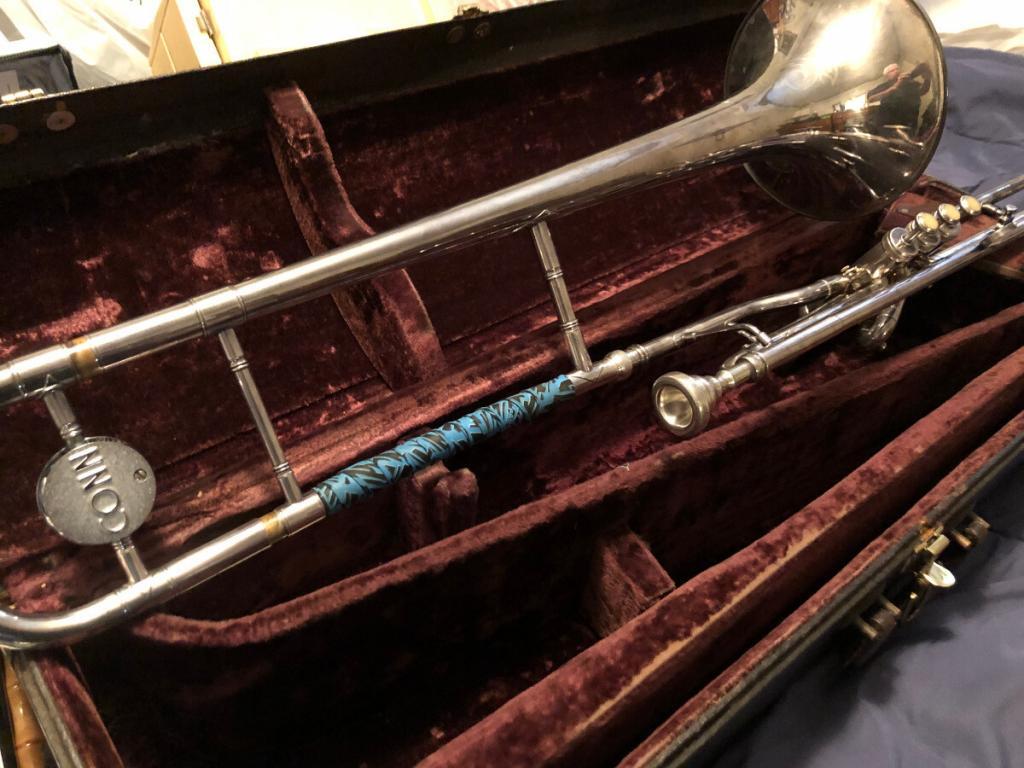
Any sensible guy would have bought it right then and there. However, I think the pawnbroker—seeing I liked the instrument—impulsively jacked up the price he quoted me. I countered, but he hung tough. He’d raised the price to almost a third of the price of a new one! But I wanted it for less. Laura thought I was out of my mind when I led us out of the store. That’s my stubborn streak that I’ve been working on all my life.
I went home, and thought about that horn. All night. The first thing the next morning, I took the subway back to the pawn shop and paid him his price. I think he actually knocked a few bucks off the price just so I’d feel better about it all.
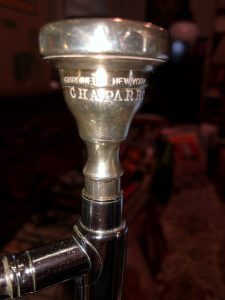 So, I got the horn home, and Laura and I got out the silver polish and went to work. The horn had come with a Giardinelli mouthpiece. Back in the day, “Giardinelli’s” was a respected music store in Manhattan. If one bought a trumpet or trombone mouthpiece from them, you could have your last name professionally stamped into its side. (No, this does not affect how the mouthpiece feels or responds). The horn’s previous owner had been a Mr.—or Ms.—“Chaparro.” I’d never heard of him/her.
So, I got the horn home, and Laura and I got out the silver polish and went to work. The horn had come with a Giardinelli mouthpiece. Back in the day, “Giardinelli’s” was a respected music store in Manhattan. If one bought a trumpet or trombone mouthpiece from them, you could have your last name professionally stamped into its side. (No, this does not affect how the mouthpiece feels or responds). The horn’s previous owner had been a Mr.—or Ms.—“Chaparro.” I’d never heard of him/her.
At some point, I noticed the brand name Olds stamped into the lower part of the valve section. I looked at the spot where that section screws into the bell. It had been modified. Parts and joints like this are not standardized among the various instrument manufacturers. Mr. Chaparro obviously liked the sound of that Conn bell, and the way it felt with the Olds valves. He’d had it all silver-plated to match. In short, it was a custom horn!
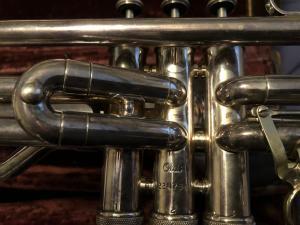
Well, I played it for a few weeks, liking the instrument more and more. I listened again to the sublime valve trombone playing of the great Juan Tizol, and showed up for the first day of recording. I think we were at Clinton Studios in Manhattan, but I’m not sure after so many years. Clinton (or wherever we were) was a spacious facility, with a very large recording room; suitable for a full symphony orchestra. I had been in New York for less than a year, and now I was surrounded by thirteen or fourteen of the finest musicians in town. As The New Yorker points out in its jazz club listings, “musicians…lead complicated lives…” With two or three weeks of steady recording, five days a week, it would be impossible to get the same personnel for each session. I can only tell you about the guys I remember from the sessions in which I took part.
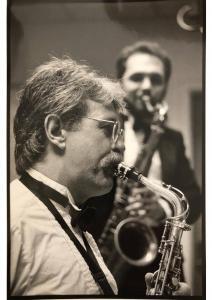
Chuck Wilson was usually in the lead alto sax chair. Chuck had played lead for Buddy Rich, and unlike many sidemen who came and went, Chuck got along amazingly well with Buddy. He stayed a couple of years, and when he broke the news to Buddy that when the band got back to New York City, Chuck intended to leave the band and stay there, Buddy threw Chuck a going-away party! A few years after the Cotton Club sessions, Chuck and I would play for Benny Goodman, and in the popular quintet I co-led with Howard Alden.
Ken Peplowski played tenor sax and some clarinet for several of the sessions. A true “star” in the band was the tenor saxophonist Frank Wess, known primarily for his consistently great playing with the consistently great Count Basie band of the 1950s. Joe Temperley—who had replaced Harry Carney in Ellington’s band, playing with Ellington himself—played baritone sax. Joe spent the last several years of his life performing with Wynton Marsalis and the Lincoln Center Jazz Orchestra.
The trumpet section included my friend Randy Sandke, and Lew Soloff. Lew had toured and recorded with Blood, Sweat, and Tears, and was a veteran of hundreds of recordings and soundtracks. He passed away in March of 2015. Laurie Frink was also often at the sessions. In addition to being a funny, hip, kind woman, she was one of the finest lead trumpet players any of us had heard in our lives, as well as a respected trumpet teacher.
The other two trombonists in our three-man section included Joel Helleny, another good friend and exceptional jazz trombonist who had his own “thing.” The history of jazz trombone informed his unique playing, and he was one of the true masters of plunger playing, in the style of our mutual hero, Joe “Tricky Sam” Nanton. I miss Joel. I think I remember Bobby Pring—another great, whose hero was Jack Jenney—showing up for a couple of sessions. Yet another trombonist with whom we recorded was a man who had spent many years with Ellington, and had made scores of recordings with him: Britt Woodman.
Mark Shane was our pianist. At that time, Mark played in Bob Wilber’s swinging little band called Bechet Legacy. Another member of that group was Cotton Club’s guitarist/banjoist, Mike Peters.
My memory is hazy about the others, but suffice it to say they were all top-notch players. Several were contracted because of their consummate abilities as sight-readers, and their overall efficiency in a studio setting. Others, like Sandke, Helleny, Shane, Peters, and myself were there because we had devoted significant portions of our jazz lives to studying the music of Duke Ellington. Of course, Temperley and Woodman had first-hand experience with that genius and his many great bands. Frank Wess is on that terrific Columbia recording called First Time, which pitted Ellington’s band against Count Basie’s. Wess plays some great solos on that record, including a couple of swinging flute solos.
At the first session, we got into our places. Our parts—heavy-stock paper music, prepared for each individual instrument in the band—were already on our music stands, professionally and laboriously hand-copied by pro copyists at one of the many offices (or “houses”) in Manhattan devoted to the profession. Like everyone else, I immediately began thumbing through the parts on my stand, searching for difficult passages, and anxiously trying to see what I’d gotten myself into.
Bob called everyone to order, and after a few welcoming remarks we were suddenly playing the first chart. A lot of worry fell away immediately, as I was reminded how easy this all can be when one is surrounded by great players. It seemed as though I could feel everyone helping each other through the arrangement.
We reached the ending, and Bob seemed happy. I think we may have gotten a “well done,” or some kind of encouragement from the booth. The “booth” was the smaller, sound-proof room adjacent to the huge room where we were set up. The booth contains all the recording equipment, and monitor speakers so the engineers (and occasionally the musicians, between takes) can hear the band, and hear back what was just recorded. The engineer sits in front of a low, flat panel of electronic switches and sliders that often stretches wall-to-wall, making the cockpit of a 747 look like an arcade game. He’s usually flanked by the session’s producer or producers, and an assistant or two. There might be a couple of VIPs who have been invited to the session relaxing on the ubiquitous leather couch that can usually be found against the wall of any studio’s booth, behind the recording engineer. There’s always coffee, and often a vending machine offering soft drinks and snacks.
We were also excited about the presence of the legendary John Barry, who had been brought in to help produce the sessions. Mr. Barry composed the iconic theme songs for the James Bond films Goldfinger and From Russia, With Love. He did not actually compose the James Bond Theme, but it’s his suspenseful orchestration that has seeped into the public consciousness. During one of the breaks, I had occasion to shake hands with him and introduce myself. I said what one always says to such a person: it’s an honor, sir, blah, blah. He was polite if reserved, but then he had a lot on his mind! I do remember—and have thought often over the years—about how Mr. Barry said nothing when nothing was needed said; he let Bob have full rein. Once in a great while, though, between takes, we would hear the electronic “pop” of the studio speakers being engaged, and then Mr. Barry’s voice would be in the room with us. He had a pronounced, aristocratic English accent.
“Uh, Bobby, excuse me,” he would say.
“Yes, John?”
“I just referenced Duke’s recording. It would seem the brass have a more ‘pungent’ quality behind Johnny Hodges’s solo at letter D. I think they might be using straight mutes instead of cups. What do you think?”
And Bob would say, “Brass! Please mark your parts to say, ‘straights’ at letter D instead of ‘cups,’ Thanks, John.”
“No problem Bobby. Another take, then?”
I remember every time Mr. Barry interjected himself, it always improved things. He might make a comment to the rhythm section. Whatever was said caused that section to play even more “together” than before. During the two weeks we were with him, he had adroit comments about: intonation, our collective rhythm, our overall balance, and various other musical elements. Whatever he said always somehow helped us in our Fool’s Errand of imitating the Duke Ellington Orchestra. It always improved things, and I came away with a good deal of respect for the man.
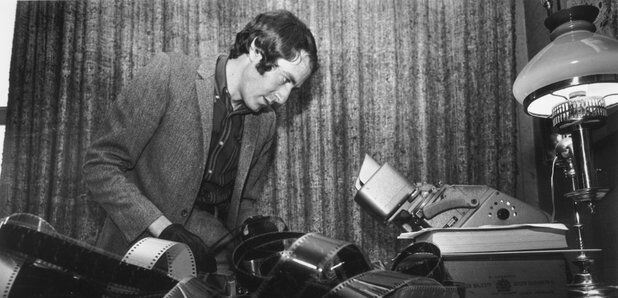
Much of what we played had to be timed exactly to action that had already been filmed. Bob would watch a large TV monitor, turned to face him. John Barry would set the tempo to something called a “click-track.” This device is like an electronic metronome, which is played—always too loudly—into your headphones. It “keeps you honest,” and prevents a band or an individual from speeding up or slowing down. If not too drastic, these human foibles are almost acceptable in live performance. In a film, however, when the music is often supposed to coincide with a certain moment of action on the screen, there can be no inaccuracy at all. Just to make things interesting, a musician is often asked to ignore the loud clicking at a certain spot in the music, and play a little faster than the click…or a little slower. This again is to match the speed of specific action on the screen which cannot be easily translated to the click. The first thing musicians do after a take is rip off the damned headphones! No one likes click-tracks.
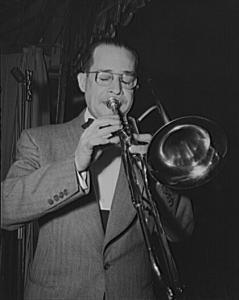
We were doing double sessions, of three hours each with brief, Union-mandated breaks. We’d have an hour off between sessions—maybe two—for lunch. Most of us were young, living in the Big Apple, and owned the world. Several—if not most—of the musicians would have a beer or two with their lunch. With so much riding on the recording, and the degree of difficulty of what we were playing, no one wanted to overdo it, and no one did. Now, Bob had told me early on that I was to play a Tizol piece called “Pyramid.” Tizol had composed it for a small group session with several other Ellington sidemen. Like other small group pieces composed by Tizol and other members of the band, “Pyramid” was later enlarged for the full orchestra.
It’s a fascinating recording. It begins with the eerie sound of a snare drum—played with the hands, instead of sticks or brushes. Just that; a drum in the distance; nothing more. After four measures of this, Tizol enters, playing his languorous melody with his haunting, melancholy sound on full naked display. He plays a full chorus backed by just that one drum. After this riveting opening chorus, the full band enters, and so begins what I always think of as Ellington’s personal “kaleidoscope” of sounds, textures, and harmonies.
I’d been sent my solo part to “Pyramid” a week or so before the first session. I had it virtually memorized. Nonetheless, this advance preparation didn’t seem to steady my nerves. The thought of actually recording this for a major motion picture soundtrack made me as nervous as a pregnant nun.
It was difficult to sit with my colleagues, watching them have a cold beer while I stuck to diet Coke and coffee. I knew a beer would calm me down, but I figured it would be just my luck to get back to the studio and see “Pyramid” sitting on the music stands. On the first day of recording, Bob smiled and asked if I was ready for my “big solo.” I told him I’d do my best. He said he couldn’t predict when it would come up in the schedule, or even what day. He just asked that I “be ready.”
Great.
So, as the sessions went on, I stayed with coffee and soft drinks. At the end of the first week, I walked into Clinton studios for another six hours of recording. Bob saw me, and hurried over.
“Hey, Dan! I found out we’re going to record your tune today!”
“Oh…that’s…that’s swell, Bob. I’m all set.” I suddenly had some idea of what Nathan Hale must have felt like there at the end.
“I don’t know when we’ll get to it, but…I know you can do it!”
I nodded, and went to my seat.
We recorded a couple of tunes. I think Mood Indigo might have been one of them, with Joel Helleny doing an especially masterful job. He seemed to “channel” Tricky Sam Nanton, using a version of Nanton’s special mute-and-plunger combination. I was glad I was there to hear it.
Finally, Bob announced “Pyramid.” The other guys riffled through the music on their stands, and found their parts. I had my part up, pages unfolded. My valves were oiled. I was ready to go. I told the engineers in the booth that I wanted to stand up to play this one. (It can affect breathing, etc.) They sent a guy out to raise the microphone in front of me. The other guys sat and waited.
So, I was just standing there. Britt Woodman was seated beside me.
“Huh,” he said.
I looked over at him. “Britt?” I said.
He kind of snorted quietly at the floor. He jerked a thumb at my instrument. Then he said, “You ain’t ever gonna sound like Tizol on THAT thing!”
The engineer had just finished adjusting the microphone, and was heading back into the booth.
I said, “Yeah, well, no one can do that, but I’ll do the best I can.” I was getting pretty nervous now. I knew the red light in the corner was going to go on any second now.
“No, man!,” Britt continued. “It ain’t you; It’s that horn. Tizol played a C valve trombone. That one you got is in B-flat!”
I had just enough time to say, “Gee…thanks,” before I heard John Barry’s voice on the speakers, slating the take: “‘Pyramid,’ take one…” The little red light came on.
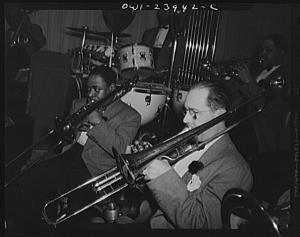
Bob pointed at the drummer. (By the way, on the original recording, it was Ellington himself who played the drums with his hands. There’s a “fun fact” for you. I’m sorry I can’t recall who played the drums on that particular track that day).
The drummer—seated across the room from me—started the rhythm I knew so well. What I didn’t realize before that moment was, all the other guys had nothing to play for quite a while. It was all just the drummer—on just one drum—and me. So, I saw the sax section all turn in their seats to watch me! The rest of the rhythm section was watching me, some with their arms crossed in front of them. I felt the eyes of the trumpet section also watching. Nothing else to do; let’s watch this trombone player from California.
Remember, I’d been a good little boy all week, watching my friends enjoy a beer or two (Chuck Wilson called it “click-track repellent”) while I had coffee, or diet Coke. Now I was being hoisted, as they say, by my own petard. I’d had several cups of coffee that morning, and had just finished another diet Coke during a brief break between takes. Between all that caffeine, and the adrenaline that was kicking in from weeks of stressing about this solo, I started shaking like a Skid Row wino. But I came in when I was supposed to, and on the right note. I kept playing. As the piece progressed, I of course was thinking about breathing, and phrasing, and my intonation, and how I might at least approximate Tizol’s special tone (achieved on his King valve trombone pitched in they key of C) with my Conn & Olds hybrid, that was—like most other valve trombones one encounters in anyone’s world but Ellington’s—in B-flat.
So far, I hadn’t hit any “clams” (wrong notes). Then I remember thinking, God! I’m shaking a lot here. Hmmm…if I don’t use any lip vibrato, the shaking sounds a little like Tizol’s vibrato…Okay…I’ll just use that…
We were about halfway through this opus when I started thinking, Oh, man! How do I get myself INTO these things? Who do I think I am? I have no right to be here. Why didn’t they call Bob Brookmeyer, or that cat Mike Fahn who plays so beautifully, or somebody who actually plays the valve trombone exclusively?
About two-thirds of the way through, I realized we were all still playing “Pyramid,” and I hadn’t missed any notes. Yet.
Then my mind went in a different direction. That wasn’t very nice of Mr, Woodman to wait all those days until right before the take to tell me about Tizol’s horn! He must have noticed it before. Was he trying to be funny? Or is he just mean? Well, I can’t think about that anymore…I’ve got to remember to breathe after the next…yeah, here it is; time for a nice big breath. Okay, Dan, you’re still doing all right. Hang in there…
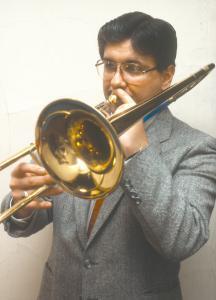
And later: You know, Dan, you’re still doing okay. You’ve got to remember, Bob might have found someone else who can play well, but you’re the guy who spent all those nights listening and studying Ellington’s recordings. You know Lawrence Brown’s playing, and Tricky Sam’s and Tizol, and—yes—Britt Woodman’s too, God bless him. Not too many guys dig that band and those musicians as much as you do. So, enjoy the fact that you’re here, and just try to do justice to Mr. Tizol.
Okay: You’re calming down now. You can do this! The next take is going to be a winner. They got the right guy for this job! I hope they go right into the next take, while I’m ready…I don’t; need a break. I sure as hell don’t need any more coffee! Hey…here’s the last note already…be careful…finish this one well, and then you can do it again “for real…”
So, I held the last note of the number, and watched as Bob cut us off. I stood there, and didn’t make a sound. Everyone was silent. Then the guys all put their instruments down, and gave me a very unexpected spontaneous round of applause. Even Britt Woodman!
After that, we heard John Barry’s voice in the room:
“That was a nice one, Bobby! Nice job, Dan. We’ve got it. Let’s go on.”
Bob started calling out the next title to be recorded. I blurted out,
“Wait! Wait a minute!”
Bob asked me if something was wrong.
“Well…I’m ready to record this now! I can really play it now! Let me have one more take.”
The guys all laughed, and Bob said, kindly, “Dan…you just played it! That was fine. Hey, man, one take!” He looked down at the music on his stand, and pulled up another chart. “Great job. We’re going on.”
And I sat down, and got up the next number. I was still employing the new Barrett Method of Tizol Vibrato. It took me a while to completely stop shaking.
Dan Barrett is a professional trombonist/ cornetist, arranger, and composer. He enjoys performing in admittedly old-fashioned jazz styles. He has recorded for Concord Records, Arbors Records, and his own Blue Swing Recordings label, among many other labels. Dan fell in love with jazz in high school, and learned to play from much older musicians from New Orleans, who had settled in the Los Angeles area. He has played at Carnegie Hall five times, and was featured in the last bands led by Swing Era icons Benny Goodman and Buck Clayton. Another highlight of Dan’s musical life—so far—was being a member of Lueder Ohlwein’s Sunset Music Company. Write to Dan at: www.DanBarrettMusic.com.






















